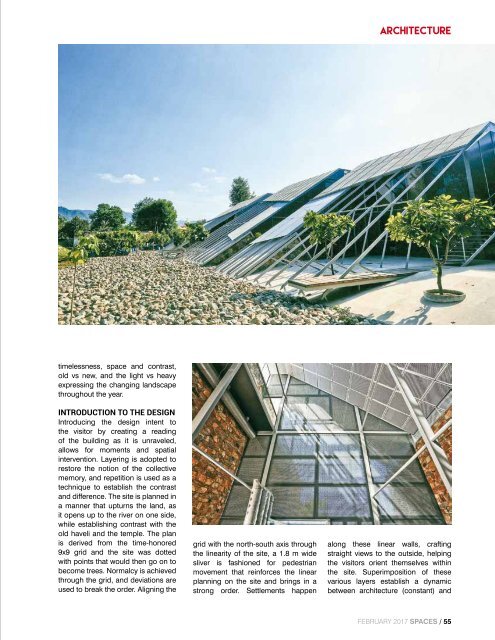SPACES feb issue 2017
You also want an ePaper? Increase the reach of your titles
YUMPU automatically turns print PDFs into web optimized ePapers that Google loves.
Architecture<br />
timelessness, space and contrast,<br />
old vs new, and the light vs heavy<br />
expressing the changing landscape<br />
throughout the year.<br />
INTRODUCTION TO THE DESIGN<br />
Introducing the design intent to<br />
the visitor by creating a reading<br />
of the building as it is unraveled,<br />
allows for moments and spatial<br />
intervention. Layering is adopted to<br />
restore the notion of the collective<br />
memory, and repetition is used as a<br />
technique to establish the contrast<br />
and difference. The site is planned in<br />
a manner that upturns the land, as<br />
it opens up to the river on one side,<br />
while establishing contrast with the<br />
old haveli and the temple. The plan<br />
is derived from the time-honored<br />
9x9 grid and the site was dotted<br />
with points that would then go on to<br />
become trees. Normalcy is achieved<br />
through the grid, and deviations are<br />
used to break the order. Aligning the<br />
grid with the north-south axis through<br />
the linearity of the site, a 1.8 m wide<br />
sliver is fashioned for pedestrian<br />
movement that reinforces the linear<br />
planning on the site and brings in a<br />
strong order. Settlements happen<br />
along these linear walls, crafting<br />
straight views to the outside, helping<br />
the visitors orient themselves within<br />
the site. Superimposition of these<br />
various layers establish a dynamic<br />
between architecture (constant) and<br />
February <strong>2017</strong> <strong>SPACES</strong> / 55


















